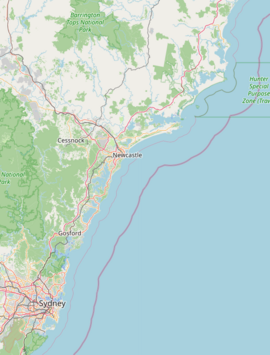Killingworth, New South Wales facts for kids
Quick facts for kids KillingworthGreater Newcastle, New South Wales |
|||||||||||||||
|---|---|---|---|---|---|---|---|---|---|---|---|---|---|---|---|
| Population | 690 (2021 census) | ||||||||||||||
| Established | 1892 | ||||||||||||||
| Postcode(s) | 2278 | ||||||||||||||
| Location | 23 km (14 mi) W of Newcastle | ||||||||||||||
| LGA(s) | City of Lake Macquarie | ||||||||||||||
| Parish | Teralba | ||||||||||||||
| State electorate(s) | Lake Macquarie | ||||||||||||||
| Federal Division(s) | Hunter | ||||||||||||||
|
|||||||||||||||
Killingworth is a small town in New South Wales, Australia. It's located south of West Wallsend, New South Wales and east of the main highway connecting Sydney and Newcastle. Killingworth is part of the City of Lake Macquarie, which is a local government area within Greater Newcastle.
Contents
History of Killingworth
Killingworth started because of coal mining. Mining took place here from 1888 until the Great Depression (a time when many people lost their jobs and money). Mining stopped for a while during the Depression, then started again until the 1960s when the coal industry slowed down a lot.
Early Mining Days
In 1895, a company called Caledonian Collieries Limited bought the mine shafts at Killingworth. They dug the shafts deeper, reaching about 268 meters (880 feet) down. Two layers of coal were found and mined. The Killingworth Colliery (coal mine) started producing coal in October 1897.
Around 1915, the mine was renamed West Wallsend Extended Colliery. However, big letters "K C" (for Killingworth Colliery) stayed on the engine rooms. The coal from this mine was moved using its own special railway line. This line connected to a larger private railway that went from Seahampton and West Wallsend to the main government railway line at Cockle Creek.
Mine Explosion
On December 7, 1910, a huge gas explosion happened in the mine pit at 5:25 AM. Luckily, no people were killed, but a horse named 'Splash' sadly died. The mine's cages (which are like elevators that carry miners and coal) were blown right up the shaft. They ended up tangled in the metal structure at the top of the mine. It took a long time to fix everything, and coal production didn't start again until August 1911.
Other Industries in Killingworth
A brick kiln (a type of oven for making bricks) was built at the colliery. There was also a sawmill, which was connected to the mine's railway by a small side track. Much of the timber used to build houses in Killingworth came from this sawmill.
In 1924, a large workshop for repairing wagons (used to carry coal) was opened. This workshop stayed open until April 1961, just 18 months before the coal mine finally closed down for good.
Education in Killingworth
Killingworth also had a public school that operated for two periods. It was open from 1891 to 1892, and then again from 1902 to 1941.



